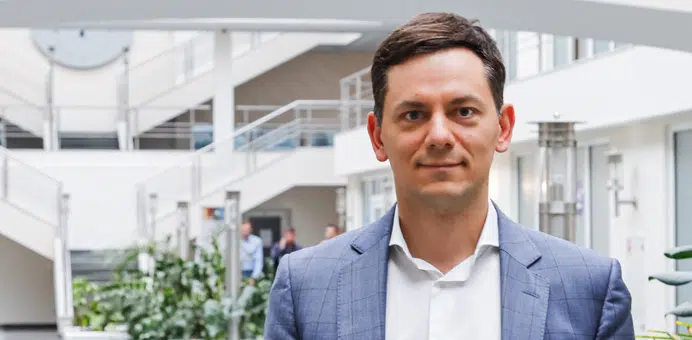Connecting all medical imaging devices into a single service, with Enterprise Imaging, supports “anywhere/anytime” access to the patients’ imaging data across the megalopolis and beyond, enabling ‘true’ teleradiology and enhanced patient care
1300 modalities, 1500 radiologists, 1500+ technicians, 10,000 referring physicians, 500,000 patients… Moscow’s Unified Radiological Information System (URIS) and its unified digital infrastructure have become a ‘one stop shop’ to access patient imaging data across the megalopolis and beyond.
And a core component of URIS is the unified Enterprise Imaging platform, offering the scalability and functionality for the present and the future of this ambitious project.
Making medical imaging more accessible to patients
The foundations for URIS were laid in 2012, during a large-scale modernization of Moscow’s healthcare services. “Hundreds of CT and MRI scanners were purchased for and installed in the primary care and out-hospital facilitie. Previously these modalities were mostly available only in hospitals,” describes Professor Sergey Morozov. “The mission was to make these types of imaging more accessible to patients, in a cost-efficient way, through the outpatient primary care and out-hospital facilitie. The success of this approach has enabled us to launch other key initiatives since then, such as a lung cancer screening program and an MRI prostate screening, to name only two.”
Very soon after the installation of the new modalities, discussions began on how to connect them within a unified information system. “This would offer clear and necessary benefits, including overall standardization, increased efficiency, efficiency metrics, and harmonized workspaces and workflows for radiologists and technicians,” Professor Morozov continues.
To enable this connection, Agfa HealthCare’s Enterprise Imaging platform was selected. Professor Morozov: “We needed a solution that could work as a radiology archive, and provide advanced tools and workflow automation for radiologists and referring physicians. It was very important to select a vendor that delivers the highest international standard for enterprise imaging. But we also needed the possibility to scale in the future, especially in terms of adding many more modalities. So when I became chief radiologist of Moscow in 2015, I was very pleased that Agfa HealthCare’s Enterprise Imaging had become part of the URIS project in 2014.”
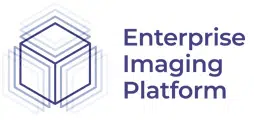
1300
modalities
1500
radiologists
1500+
technicians
10,000
referring physicians
500,000
patients
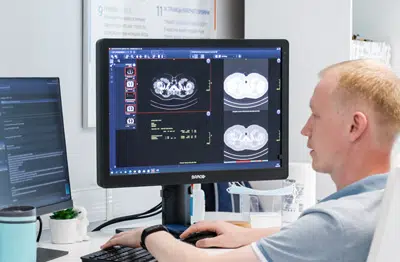
A unified service offering access to all of the patient’s images
The overall goal was to integrate all local radiology services into the URIS service; the first challenge was connecting multiple modalities from different sites by February 2015- only one month after the signing of the contract. By mid-2015, all the CT and MRI modalities from the primary care and out-hospital facilities were not only connected but integrated in the advanced diagnostic workflow automated by Enterprise Imaging.
Professor Morozov: “Different workflow approaches were implemented, such as cross-reporting, where radiologists at one primary care and out-hospital facility would report studies carried out at another primary care and out-hospital facility. True teleradiology and remote reporting, dashboards for productivity analysis and peer review, were also tested, with more modules added to make this possible. We continue to tune these approaches, with the support of the Agfa HealthCare application specialists”
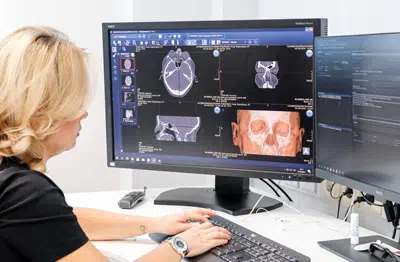
Big jump: from 700,000 to 5 million studies annually
In 2018, the project took a huge leap forward, when the city’s new vice-mayor in charge of healthcare decided to leverage all of the informatics, by having all CT, MRI, mammography, digital X-ray and X-ray angiography devices in hospitals and primary care and out-hospital facilities connected to URIS by the end of 2019.
“This meant connecting 1200 more modalities. It was very important that Enterprise Imaging was able to scale to meet the massive growth in demand. It enabled us to increase from 100 to 1300 modalities very quickly and seamlessly,” says Professor Morozov.
With the decision, the estimated yearly volume of images handled by the Enterprise Imaging platform exploded from 700,000 up to 5 million. So in 2019 Agfa HealthCare split the platform into two clusters: one for the primary care and out-hospital facilities, one for the hospitals. To handle the migration and upscaling, Agfa HealthCare, local partner ITco and the Moscow Department of Information Technologies (DIT) collaborated closely, 24/7, to support optimal performance while keeping resources allocation requirements in mind.
Following this evolution, the number of radiologists using the platform for viewing and reporting increased from 199 in 2015 to 1,100 by the end of 2020.
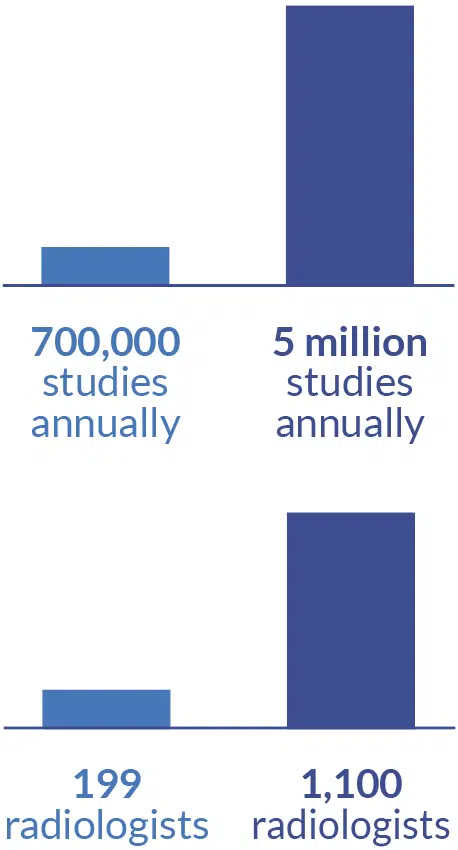
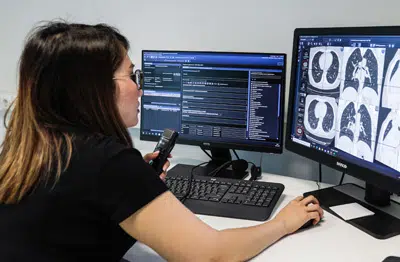
“Worklist management enables us to distribute studies among our radiologists, based on subspeciality rather than location. Every study is thus reported by an expert in that subspeciality, not for example, the radiologist who happens to be in the hospital or primary care and out-hospital facility on that day.”
Worklist management supports ‘expert’ radiology
The task-based workflow management is a key functionality in Enterprise Imaging for each radiologist on the platform. It adds value not only for the radiologists, but also for technologists, referring physicians, patients and the healthcare system overall. “Worklist management based on automated task assignment enables us to distribute studies among our radiologists, based on subspeciality rather than location. Every study is thus reported by an expert in that subspeciality, not, for example, the radiologist who happens to be in the hospital or primary care and out-hospital facility on that day.”
This distributed way of working has had several very important benefits for radiologists across all locations, he continues. “Firstly, we can reduce second readings, because every report is already an ‘expert’ report. Secondly, radiologist satisfaction has increased, because these professionals are working with their familiar studies and pathologies.
Furthermore, as the radiologists have the specific knowledge needed for the studies they are working on, report turnaround time has drastically improved. Five years ago, it was five days. Now it is on average less than one hour! This is a very important metric for patient care quality, as it means the referring physician and the patient have access to the diagnostic information much more quickly.”
Other functionalities enabling a more comfortable and efficient workflow for radiologists include the ease of switching from one working place to another, and helpful tools such as hanging protocols.
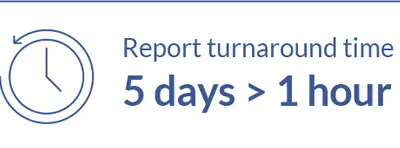
Centralized remote reporting enhances productivity
The centralized, standardized platform was also key to enable the launch of the Moscow Reference Center for Radiology (MRC): the first teleradiology center created as part of the public healthcare system. Opened in 2020, it now has 96 radiologists remotely reporting some 25,000 imaging studies each week and plans are to grow the number of radiologists even further.
Radiologist productivity has doubled with the MRC, Professor Morozov explains. “Around the clock IT support, dedicated workstations with diagnostic monitors and automated worklist management provide the radiologists with an environment that is very conducive to efficiency. In fact, because radiologist productivity has doubled, we can make the same number of reports with half the radiologists.
Not only is this more cost-effective, but it allows us to provide additional specialized training to upgrade the radiologists’ skills. We can also deliver more and better services to remote locations. Russia is a huge country, and it is not possible to provide an expert radiologist for every CT machine. But by connecting those devices to the digital infrastructure, we can increase the reach of this critical imaging insight to more patients, and remotely report the studies. ‘Expert As A Service’, in a way.”
“With around the clock IT support, dedicated workstations with diagnostic monitors and automated worklist management… radiologist productivity has doubled, so we can make the same number of reports with half the radiologists.”
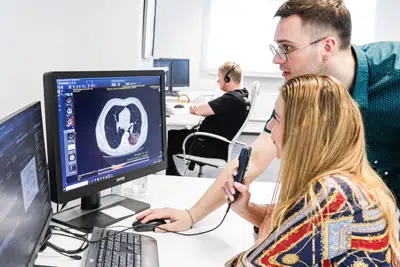
Standardized workplaces and anywhere/anytime image access
Beyond the centralized reading and reporting services at the MRC, the digital infrastructure and unified platform have enabled a standardization and harmonization of radiologist workplaces in every hospital in the city. “This allows us to smoothly transfer images from the primary care and out-hospital facilities to the hospitals, which reduces repeated studies,” describes Professor Morozov.
The XERO universal viewer plays a key role, providing “anywhere, anytime” access to the patient’s imaging record – not only for the radiologist, but for all stakeholders. “Radiologists might use XERO to quickly and remotely check a patient study that requires specific attention, for instance. And in the future, I am convinced the XERO functionality will be an important step in truly freeing radiologists from their physical locations,” he explains.
As new service lines have been connected to the digital infrastructure, other specialists have been increasingly making use of the functionalities, as well. “When we connected the angiography devices, vascular surgeons began using the platform to inform about their decisions regarding operations on stroke and myocardial infarction patients, for example. Traumatologists and ENT surgeons also use it, to check CT, MRI and X-ray results.”
Private PET-CT centers such as those specializing in oncology imaging are also connected, giving referring oncologists at the hospitals access to the PET-CT scans taken at those private centers. And with XERO embedded in their electronic health records, referring physicians can directly check patients’ images: in the last year, nearly 10,000 did so.
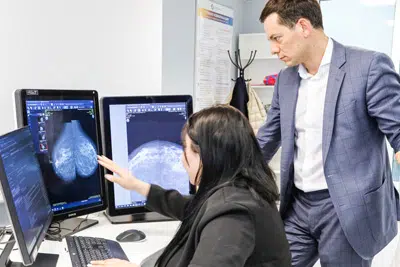
Empowered patients and continuous quality improvements
Patients also have easier access to their own information: 500,000 patients have downloaded their imaging studies and reports from their electronic health records. “This access empowers the patient, making it easier for them to get a second opinion, for example. Looking back 20 years ago, patients were ‘bound’ to their healthcare provider literally because of the notoriously bad handwriting of the doctor: it wasn’t legible, so only the doctor had full access to these notes. Now, patients can take their data anywhere.
It also raises the possibility that several years in the future, a patient may come back and say ‘you missed a tumor in this lung image, and now it has grown from 1 mm to 10 cm’. But it is always better for the healthcare system to have information, rather than not have it. This kind of pressure on hospitals and physicians, which drives quality improvement, is good for everyone in the end.”
Rapid COVID-19 response
When COVID-19 unexpectedly hit in early 2020, the URIS digital infrastructure was ready to meet the needs and demands of the healthcare crisis. “We were able to leverage our set-up to support the response. For the first months, PCR testing was not widely available, and the doctors didn’t yet have a clear vision on how to differentiate COVID-19 from acute viral disease. CT lung scans were the primary method for diagnosis.”
Agfa HealthCare and its local partners worked closely with the Department of Information Technologies of Moscow (DIT) to connect the primary care and out-hospital facility cluster and the hospital cluster, to enable even faster sharing of studies from one to the other. Federal and private centers were also connected.
“This allowed us to perform COVID-19 triage at the outpatient clinics, and quickly transfer patients to the hospital when needed. As hospital resources became overstressed, we were able to add the federal and private hospitals to the network,” he explains.
“Using the digital infrastructure, we quickly standardized CT reporting for COVID-19 diagnosis, remotely taught our radiologists how to read them, developed a standardized CT scale grading for COVID-19 severity and pulmonary impact, and then spread that knowledge around the world.”
“Using the digital infrastructure, we quickly standardized CT reporting for COVID-19 diagnosis, remotely taught our radiologists how to read them, developed a standardized CT scale grading for COVID-19 severity and pulmonary impact, and then spread that knowledge around the world.”
Prof. Sergey Morozov
Creating a collaborative learning environment
“The Enterprise Imaging platform includes an online collaboration functionality, that enables a radiologist to contact a more experienced radiologist for support with a diagnosis. Peer review for us is definitely not only about quality review, but about creating a learning environment. The radiologist requesting the second opinion is learning from their more experienced peer. Normally, these consultation requests decrease over time. When they don’t, we can monitor the situation and determine if the radiologist could benefit from some additional training. This provides more objective feedback and encourages more learning,” Professor Morozov describes.
Peer review can also help to highlight possible discrepancies in reporting, for example a missed diagnosis or missed incidental finding. “It’s important that the reading specialist pay attention to everything in the image, not just the ‘target’ area. For example, if the expert is looking at an aortic CT, and misses an ovarian tumor that is visible in the image, this is not acceptable. Peer review has enabled us to have very constructive discussions to make it clear what we expect, and that someone is watching and checking, to promote continuous quality improvement.”
Artificial intelligence
The standardization of the datasets in the archives is also supporting the development of Artificial Intelligence tools to further support the radiology services. “We have over 1,500,000 studies that are being analyzed by AI algorithms from different vendors: not only from Russia, but from around the world. The anonymized data goes directly from URIS to the AI tool and back again. The studies are then received by our radiologists pre-analyzed by the AI. This can help reduce the risk of human error, decrease the burden on the radiologist for routine tasks, and let the radiologist focus on the pathology and studies that require his expertise for prompt analysis and reporting,” he describes.
“We also have a huge database of COVID-19 lung CTs, which we have used as the primary diagnosis tool during the pandemic. Our peers test their AI algorithms on our datasets, and they refer to our datasets, which include the classification of disease severity.”
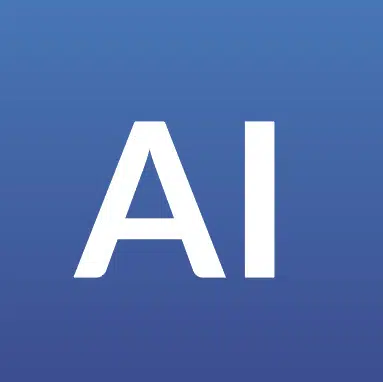
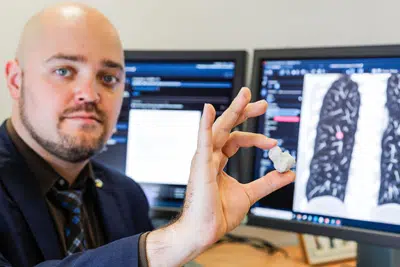
The human side of technological advances
While digital technologies in healthcare are fundamental to achieving the productivity, cost and care benefits Professor Morozov has outlined, it is important, he says, to remember that technology is an instrument, and the heart of both healthcare and technology is people.
The flexibility and dedication of the Agfa HealthCare team have played a critical role in the stages of the project over the years. Most recently, for example, Agfa HealthCare team resources have been instrumental in integrating a local, third-party voice recognition system, as well as for testing the integration with a number of AI algorithms.
“Furthermore, from the beginning, you have to keep in mind the people who will use the technology, how they accept it, whether they are ready for it, etc. And this digital infrastructure we have built with Agfa HealthCare is ultimately about people: including the local, technical and project expertise Agfa HealthCare has brought. I am very pleased that Agfa HealthCare is part of this project.”
Agfa HealthCare solution
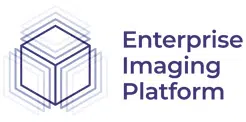
Enterprise Imaging is a secure, scalable platform that converges images and imaging data so that it can be viewed and shared, in real time. The Enterprise Imaging platform transforms the medical imaging ecosystem; enables multi-specialty, multi-site collaboration; empowers extended and connected care, and provides physicians with the insight they need to make informed decisions.

The XERO universal viewer enables radiologists and referring physicians “anywhere, anytime“ access to the patient’s holistic imaging history.
URIS
- 162 medical facilities belonging to the Moscow Health Care Department
- 1,102 radiologists
- More than 30,000 studies a day
- More than 10,500,000 studies uploaded – 5,284,556 of which in 2020
- 10,000 referring physicians check images and reports online
- More than 500,000 patients have downloaded their images and reports
- Report turnaround time reduced from 5 days to 1 hour
- Half the number of radiologists needed for the same number of reports
- 1,371 diagnostic devices connected:
- 192 CT scanners
- 97 MRI scanners
- 53 angiography machines
- 21 PET/CT scanners
- 630 X-ray units
- 30 densitometers
- 119 mammography scanners
- 3 SPECT-CT machines
- 12 gamma cameras
- 214 photofluorography scanners


